Humans-as-a-Sensor for Buildings—Intensive Longitudinal Indoor Comfort Models
Abstract
1. Introduction
1.1. Can Longitudinal Human Perception Feedback Supplement Sensors?
1.2. Paper Overview
2. Background and Novelty
2.1. Indoor Environmental Comfort Variables and Models
2.2. Ecological Momentary Assessments (EMA)
2.3. Similar Work in Intensive Longitudinal Data Collection in the Built Environment
2.4. Novelty of Proposed Approach
- The hardware and software deployment methodology has a focus on practicality in scalable, field-based implementations. Experimental participants were only asked to wear a single smartwatch device and answer survey questions that utilise a relatively small amount of time. The focus was on testing a configuration that was easily applied in a real-world context. The modelling methodology was designed to maximise data capture in the field without constant control and verification of sensor proximity and accuracy.
- A series of pre-processing steps were developed to convert intensive longitudinal data into model input features that characterise the tendency of groups of people to have similar comfort preferences. A simple example of this concept is the commonly discussed, yet often anecdotal, person who seems always to need more cooling, even when the temperature is already low relative to the comfort zone. In this study, clustering was used to group people into comfort preference types as an input feature to a preference prediction model.
- This paper introduces and tests a simple form of a cold start variant to the preference models that could be used to predict an occupant’s preference. Cold start refers to a model with limited or no data about the occupant’s preference history in a particular space or according to particular objective measurements such as temperature, humidity, or other factors. This model enables the deployment of the cozie data collection methodology by a set of participants in a building and then the creation of prediction models that could accommodate future occupants regardless of whether they have worn a smartwatch in those spaces.
- The process seeks to show that comfort-based preference prediction can be accurate even in the absence of environmental sensors if enough intensive longitudinal data has been collected from sufficient occupants. The context of this experiment was in a relatively uncontrolled, field-based settings as opposed to laboratory conditions.
3. Methodology
3.1. Tier 1: Smartwatch for Micro-EMA
3.2. Tier 2: Indoor Localisation
3.3. Tier 3: Preference Data Convergence with Environmental Sensors
3.4. Tier 1b: Strap-Mounted Sensor Kit
3.5. Occupant and Room Preference Clustering
3.6. Occupant Comfort Preference Prediction
- Time was created through feature engineering the time stamp of when an occupant gave feedback. This feature was a cyclical representation of the hour of the day and day of the week. This simple feature type detects if certain cyclical habits or components have a role in preference prediction and was included in all scenarios.
- Environmental Sensors were features extracted from measurement data from lighting (lux level), noise (dB level), temperature (deg. Celsius), and relative humidity (RH%) measurement. These variables were collected from the IEQ sensors that were in the same zone as the occupant, and closest spatially and temporally to the occupant when they gave feedback.
- Near Body Temperature was a feature created from the temperature sensor mounted on the smartwatch strap that had temporal proximity to the time-stamp of when the occupant gave feedback.
- Heart Rate was collected from the Fitbit smartwatch device as an instantaneous value collected when the occupant gave feedback.
- Room was a feature that was encoded to a numerical preference type based on the history of feedback in the room in which the survey was taken. This feature was designed to increase the prediction accuracy by complimenting data from rooms of similar comfort profiles. For example, if an occupant only works from their office, the model will still be able to accurately predict how that occupant may feel in other rooms that have a similar comfort profile to their office.
- Preference History features are similar to the Room features. These features use the ratio of responses of each type (thermal, visual, and aural) that were calculated for each user. This ratio was only calculated for the responses of prefer-cooler, prefer-warmer, prefer-dimmer, prefer-brighter, prefer-quieter, and prefer-louder. For example, the ratio of response of prefer-cooler responses of a given occupant is calculated the following way: .
4. Results
4.1. Grouping Comfort Preference Tendencies
4.2. Tagging the Spatial Context with Preference Feedback
4.3. Correlation with Indoor Environmental Quality Variables
4.4. Predicting Field-Based Indoor Preference Using Intensive Longitudinal Data
4.5. Cold-Start Comfort Preference Prediction
4.6. Predicting Continuous Comfort Preference without Sensors
5. Discussion
5.1. Practical Application of Intensive Longitudinal Data in Industry
5.1.1. Post-Occupancy Evaluation, Commissioning, and Sensor Calibration
5.1.2. Potential for Spatial Recommendation Systems and Impact on Activity-Based Workspace Design
5.1.3. Integration into Building Control Systems
5.2. Prediction Models Are Only as Good as the Training Data
6. Conclusions
Author Contributions
Funding
Acknowledgments
Conflicts of Interest
References
- Frontczak, M.; Schiavon, S.; Goins, J.; Arens, E.; Zhang, H.; Wargocki, P. Quantitative relationships between occupant satisfaction and satisfaction aspects of indoor environmental quality and building design. Indoor Air 2012, 22, 119–131. [Google Scholar] [CrossRef] [PubMed]
- Sakellaris, I.; Saraga, D.; Mandin, C.; Roda, C.; Fossati, S.; De Kluizenaar, Y.; Carrer, P.; Dimitroulopoulou, S.; Mihucz, V.; Szigeti, T.; et al. Perceived indoor environment and occupants’ comfort in European “modern” office buildings: The OFFICAIR study. Int. J. Environ. Res. Public Health 2016, 13, 444. [Google Scholar] [CrossRef] [PubMed]
- Fanger, P.O. Thermal Comfort. Analysis and Applications in Environmental Engineering; McGraw-Hill: New York, NY, USA, 1970. [Google Scholar]
- De Dear, R.; Brager, G.S. Developing an adaptive model of thermal comfort and preference. ASHRAE Trans. 1998, 104, 145–167. [Google Scholar]
- Asadi, I.; Hussein, I.; Palanisamy, K.; Conference, W.; Comfort, M.; Cumberland, R.; Use, E.; Environmental, C.; Engineering, M.; Mesiano, V.; et al. A survey of evaluation methods used for holistic comfort assessment. PLoS ONE 2016, 953–954, 1513–1519. [Google Scholar] [CrossRef]
- Tang, H.; Ding, Y.; Singer, B. Interactions and comprehensive effect of indoor environmental quality factors on occupant satisfaction. Build. Environ. 2020, 167. [Google Scholar] [CrossRef]
- Henry, C.; Emery, B. Effect of spiced food on metabolic rate. Hum. Nutr. Clin. Nutr. 1986, 40, 165–168. [Google Scholar] [PubMed]
- Swaminathan, R.; King, R.; Holmfield, J.; Siwek, R.; Baker, M.; Wales, J. Thermic effect of feeding carbohydrate, fat, protein and mixed meal in lean and obese subjects. Am. J. Clin. Nutr. 1985, 42, 177–181. [Google Scholar] [CrossRef] [PubMed]
- Nicol, J.F.; Wilson, M. A critique of European Standard EN 15251: Strengths, weaknesses and lessons for future standards. Build. Res. Inf. 2011, 39, 183–193. [Google Scholar] [CrossRef]
- Webster, T.; Bauman, F.; Anwar, G. CBE Portable Wireless Monitoring System (PWMS): UFAD Systems Commissioning Cart Design Specifications and Operating Manual. In Internal Report; Center for the Built Environment; UC Berkeley: Berkeley, CA, USA, 2007; p. 4. [Google Scholar]
- Choi, J.H.; Loftness, V.; Aziz, A. Post-occupancy evaluation of 20 office buildings as basis for future IEQ standards and guidelines. Energy Build. 2012, 46, 167–175. [Google Scholar] [CrossRef]
- Kim, H. Methodology for Rating a Building’s Overall Performance based on the ASHRAE/CIBSE/USGBC Performance Measurement Protocols for Commercial Buildings. J. Chem. Inf. Model. 2013, 53, 1689–1699. [Google Scholar] [CrossRef]
- Parkinson, T.; Parkinson, A.; de Dear, R. Continuous IEQ monitoring system: Context and development. Build. Environ. 2019, 149, 15–25. [Google Scholar] [CrossRef]
- Schiavon, S.; Yang, B.; Donner, Y.; Chang, V.C.; Nazaroff, W.W. Thermal comfort, perceived air quality, and cognitive performance when personally controlled air movement is used by tropically acclimatized persons. Indoor Air 2017, 27, 690–702. [Google Scholar] [CrossRef] [PubMed]
- Hodder, S.G.; Parsons, K. The effects of solar radiation on thermal comfort. Int. J. Biometeorol. 2007, 51, 233–250. [Google Scholar] [CrossRef]
- Kräuchi, K. How is the circadian rhythm of core body temperature regulated? Clin. Auton. Res. 2002, 12, 147–149. [Google Scholar] [CrossRef] [PubMed]
- Chinazzo, G.; Wienold, J.; Andersen, M. Daylight affects human thermal perception. Sci. Rep. 2019, 9, 1–15. [Google Scholar] [CrossRef] [PubMed]
- Halawa, E.; van Hoof, J.; Soebarto, V. The impacts of the thermal radiation field on thermal comfort, energy consumption and control—A critical overview. Renew. Sustain. Energy Rev. 2014, 37, 907–918. [Google Scholar] [CrossRef]
- Fukazawa, T.; Havenith, G. Differences in comfort perception in relation to local and whole body skin wettedness. Eur. J. Appl. Physiol. 2009, 106, 15–24. [Google Scholar] [CrossRef]
- Kingma, B.; Frijns, A.; van Marken Lichtenbelt, W. The thermoneutral zone: Implications for metabolic studies. Front. Biosci. (Elite Ed.) 2012, 4, 1975–1985. [Google Scholar] [CrossRef]
- Tikuisis, P.; Ducharme, M.B. The effect of postural changes on body temperatures and heat balance. Eur. J. Appl. Physiol. Occup. Physiol. 1996, 72, 451–459. [Google Scholar] [CrossRef] [PubMed]
- Gagge, A.P.; Stolwijk, J.; Hardy, J. Comfort and thermal sensations and associated physiological responses at various ambient temperatures. Environ. Res. 1967, 1, 1–20. [Google Scholar] [CrossRef]
- Gaesser, G.A.; Brooks, G.A. Muscular efficiency during steady-rate exercise: Effects of speed and work rate. J. Appl. Physiol. 1975, 38, 1132–1139. [Google Scholar] [CrossRef] [PubMed]
- Havenith, G.; Kuklane, K.; Fan, J.; Hodder, S.; Ouzzahra, Y.; Lundgren, K.; Au, Y.; Loveday, D.L. A database of static clothing thermal insulation and vapor permeability values of non-western ensembles for use in ASHRAE Standard 55, ISO 7730, and ISO 9920 CH-15-018 (RP-1504). ASHRAE Trans. 2015, 121, 1. [Google Scholar]
- Johnson, J.M.; Kellogg, D.L., Jr. Thermoregulatory and thermal control in the human cutaneous circulation. Front. Biosci. (Schol Ed.) 2010, 2, 825–853. [Google Scholar] [PubMed]
- Zhang, H.; Hedge, A. Laptop heat and models of user thermal discomfort. In Proceedings of the Human Factors and Ergonomics Society Annual Meeting; SAGE Publications Sage: Los Angeles, CA, USA, 2014; Volume 58, pp. 1456–1460. [Google Scholar]
- Karjalainen, S. Thermal comfort and gender: A literature review. Indoor Air 2012, 22, 96–109. [Google Scholar] [CrossRef]
- Huang, H.W.; Wang, W.C.; Lin, C.C.K. Influence of age on thermal thresholds, thermal pain thresholds, and reaction time. J. Clin. Neurosci. 2010, 17, 722–726. [Google Scholar] [CrossRef]
- Havenith, G.; Holmér, I.; Parsons, K. Personal factors in thermal comfort assessment: Clothing properties and metabolic heat production. Energy Build. 2002, 34, 581–591. [Google Scholar] [CrossRef]
- Frank, S.M.; Raja, S.N.; Bulcao, C.F.; Goldstein, D.S. Relative contribution of core and cutaneous temperatures to thermal comfort and autonomic responses in humans. J. Appl. Physiol. 1999, 86, 1588–1593. [Google Scholar] [CrossRef]
- Boulant, J.A. Role of the preoptic-anterior hypothalamus in thermoregulation and fever. Clin. Infect. Dis. 2000, 31, S157–S161. [Google Scholar] [CrossRef]
- Cabanac, M. Physiological role of pleasure. Science 1971, 173, 1103–1107. [Google Scholar] [CrossRef]
- Brainard, G.C.; Hanifin, J.P.; Greeson, J.M.; Byrne, B.; Glickman, G.; Gerner, E.; Rollag, M.D. Action spectrum for melatonin regulation in humans: Evidence for a novel circadian photoreceptor. J. Neurosci. 2001, 21, 6405–6412. [Google Scholar] [CrossRef]
- Perez, R.; Ineichen, P.; Seals, R.; Michalsky, J.; Stewart, R. Modeling daylight availability and irradiance components from direct and global irradiance. Sol. Energy 1990, 44, 271–289. [Google Scholar] [CrossRef]
- Leather, P.; Pyrgas, M.; Beale, D.; Lawrence, C. Windows in the workplace: Sunlight, view, and occupational stress. Environ. Behav. 1998, 30, 739–762. [Google Scholar] [CrossRef]
- Dai, Q.; Hao, L.; Lin, Y.; Cui, Z. Spectral optimization simulation of white light based on the photopic eye-sensitivity curve. J. Appl. Phys. 2016, 119, 053103. [Google Scholar] [CrossRef]
- Slater, A.I.; Boyce, P.R. Illuminance uniformity on desks: Where is the limit? Light. Res. Technol. 1990, 22, 165–174. [Google Scholar] [CrossRef]
- Baron, R.A.; Rea, M.S.; Daniels, S.G. Effects of indoor lighting (illuminance and spectral distribution) on the performance of cognitive tasks and interpersonal behaviors: The potential mediating role of positive affect. Motiv. Emot. 1992, 16, 1–33. [Google Scholar] [CrossRef]
- Wilkins, A.J.; Nimmo-Smith, I.; Slater, A.I.; Bedocs, L. Fluorescent lighting, headaches and eyestrain. Light. Res. Technol. 1989, 21, 11–18. [Google Scholar] [CrossRef]
- Main, A.; Dowson, A.; Gross, M. Photophobia and phonophobia in migraineurs between attacks. Headache J. Head Face Pain 1997, 37, 492–495. [Google Scholar] [CrossRef]
- Yin, J.; Zhu, S.; MacNaughton, P.; Allen, J.G.; Spengler, J.D. Physiological and cognitive performance of exposure to biophilic indoor environment. Build. Environ. 2018, 132, 255–262. [Google Scholar] [CrossRef]
- Hopkinson, R.G. Glare from daylighting in buildings. Appl. Ergon. 1972, 3, 206–215. [Google Scholar] [CrossRef]
- Pierrette, M.; Parizet, E.; Chevret, P.; Chatillon, J. Noise effect on comfort in open-space offices: Development of an assessment questionnaire. Ergonomics 2015, 58, 96–106. [Google Scholar] [CrossRef]
- Job, R. Community response to noise: A review of factors influencing the relationship between noise exposure and reaction. J. Acoust. Soc. Am. 1988, 83, 991–1001. [Google Scholar] [CrossRef]
- Kim, J.; De Dear, R. Workspace satisfaction: The privacy-communication trade-off in open-plan offices. J. Environ. Psychol. 2013, 36, 18–26. [Google Scholar] [CrossRef]
- Templeton, D.; Saunders, D. Acoustic Design; Elsevier: Amsterdam, The Netherlands, 2014. [Google Scholar]
- Lee, S.Y.; Brand, J. Can personal control over the physical environment ease distractions in office workplaces? Ergonomics 2010, 53, 324–335. [Google Scholar] [CrossRef] [PubMed]
- Kjellberg, A.; Sköldström, B. Noise annoyance during the performance of different nonauditory tasks. Percept. Mot. Skills 1991, 73, 39–49. [Google Scholar] [CrossRef] [PubMed]
- Banbury, S.P.; Berry, D.C. Office noise and employee concentration: Identifying causes of disruption and potential improvements. Ergonomics 2005, 48, 25–37. [Google Scholar] [CrossRef]
- Cheung, T.; Schiavon, S.; Parkinson, T.; Li, P.; Brager, G. Analysis of the accuracy on PMV–PPD model using the ASHRAE Global Thermal Comfort Database II. Build. Environ. 2019, 153, 205–217. [Google Scholar] [CrossRef]
- Stone, A.A.; Shiffman, S.; Atienza, A.A.; Nebeling, L.; Stone, A.; Shiffman, S.; Atienza, A.; Nebeling, L. Historical roots and rationale of ecological momentary assessment (EMA). In The Science of Real-Time Data Capture: Self-Reports in Health Research; Oxford University Press: Oxford, UK, 2007; pp. 3–10. [Google Scholar]
- Intille, S.; Haynes, C.; Maniar, D.; Ponnada, A.; Manjourides, J. μEMA: Microinteraction-based ecological momentary assessment (EMA) using a smartwatch. In Proceedings of the 2016 ACM International Joint Conference on Pervasive and Ubiquitous Computing, Heidelberg, Germany, 12–16 September 2016; pp. 1124–1128. [Google Scholar]
- Wang, D.; Amin, M.T.; Li, S.; Abdelzaher, T.; Kaplan, L.; Gu, S.; Pan, C.; Liu, H.; Aggarwal, C.C.; Ganti, R.; et al. Using humans as sensors: An estimation-theoretic perspective. In Proceedings of the 13th International Symposium on Information Processing in Sensor Networks, Berlin, Germany, 15–17 April 2014; pp. 35–46. [Google Scholar]
- Avvenuti, M.; Cimino, M.G.C.A.; Cresci, S.; Marchetti, A.; Tesconi, M. A framework for detecting unfolding emergencies using humans as sensors. Springerplus 2016, 5, 43. [Google Scholar] [CrossRef]
- Vielberth, M.; Menges, F.; Pernul, G. Human-as-a-security-sensor for harvesting threat intelligence. Cybersecurity 2019, 2, 23. [Google Scholar] [CrossRef]
- Heinzerling, D.; Schiavon, S.; Webster, T.; Arens, E. Indoor environmental quality assessment models: A literature review and a proposed weighting and classification scheme. Build. Environ. 2013, 70, 210–222. [Google Scholar] [CrossRef]
- Ncube, M.; Riffat, S. Developing an indoor environment quality tool for assessment of mechanically ventilated office buildings in the UK—A preliminary study. Build. Environ. 2012, 53, 26–33. [Google Scholar] [CrossRef]
- Wong, L.T.; Mui, K.W.; Hui, P.S. A multivariate-logistic model for acceptance of indoor environmental quality (IEQ) in offices. Build. Environ. 2008, 43, 1–6. [Google Scholar] [CrossRef]
- Lai, A.C.; Mui, K.W.; Wong, L.T.; Law, L.Y. An evaluation model for indoor environmental quality (IEQ) acceptance in residential buildings. Energy Build. 2009, 41, 930–936. [Google Scholar] [CrossRef]
- Cohen, R.; Standeven, M.; Bordass, B.; Leaman, A. Assessing building performance in use 1: The Probe process. Build. Res. Inf. 2001, 29, 85–102. [Google Scholar] [CrossRef]
- Webster, T.; Arens, E.; Anwar, G.; Bonnell, J.; Bauman, F.; Brown, C. UFAD Commissioning Cart: Design Specifications and Operating Manual. In Internal Report; Center for the Built Environment; UC Berkeley: Berkeley, CA, USA, 2007. [Google Scholar]
- Jin, M.; Liu, S.; Schiavon, S.; Spanos, C. Automated mobile sensing: Towards high-granularity agile indoor environmental quality monitoring. Build. Environ. 2018, 127, 268–276. [Google Scholar] [CrossRef]
- Porter, S.R.; Whitcomb, M.E.; Weitzer, W.H. Multiple surveys of students and survey fatigue. New Dir. Inst. Res. 2004, 2004, 63–73. [Google Scholar] [CrossRef]
- Liu, S.; Schiavon, S.; Das, H.P.; Jin, M.; Spanos, C.J. Personal thermal comfort models with wearable sensors. Build. Environ. 2019, 162, 106281. [Google Scholar] [CrossRef]
- Aryal, A.; Becerik-Gerber, B. A comparative study of predicting individual thermal sensation and satisfaction using wrist-worn temperature sensor, thermal camera and ambient temperature sensor. Build. Environ. 2019, 160, 106223. [Google Scholar] [CrossRef]
- Clear, A.K.; Mitchell Finnigan, S.; Olivier, P.; Comber, R. ThermoKiosk: Investigating Roles for Digital Surveys of Thermal Experience in Workplace Comfort Management. Proc. CHI 2018, 1–12. [Google Scholar] [CrossRef]
- Engelen, L.; Held, F. Understanding the office: Using ecological momentary assessment to measure activities, posture, social interactions, mood, and work performance at the workplace. Buildings 2019, 9, 54. [Google Scholar] [CrossRef]
- Monnot, B.; Wilhelm, E.; Piliouras, G.; Zhou, Y.; Dahlmeier, D.; Lu, H.Y.; Jin, W. Inferring Activities and Optimal Trips: Lessons From Singapore’s National Science Experiment. In Complex Systems Design & Management Asia; Springer International Publishing: Berlin/Heidelberg, Germany, 2016; pp. 247–264. [Google Scholar]
- Wilhelm, E.; Zhou, Y.; Zhang, N.; Kee, J.; Loh, G.; Tippenhauer, N. Sensg: Large-Scale Deployment of Wearable Sensors for Trip and Transport Mode Logging. In Proceedings of the Transportation Research Board 95th Annual Meeting, Washington, DC, USA, 10–14 January 2016. [Google Scholar]
- Benita, F.; Bansal, G.; Tunçer, B. Public spaces and happiness: Evidence from a large-scale field experiment. Health Place 2019, 56, 9–18. [Google Scholar] [CrossRef]
- Ojha, V.K.; Griego, D.; Kuliga, S.; Bielik, M.; Buš, P.; Schaeben, C.; Treyer, L.; Standfest, M.; Schneider, S.; König, R.; et al. Machine learning approaches to understand the influence of urban environments on human’s physiological response. Inf. Sci. 2019, 474, 154–169. [Google Scholar] [CrossRef]
- Rahaman, M.S.; Liono, J.; Ren, Y.; Chan, J.; Kudo, S.; Rawling, T.; Salim, F.D. An Ambient-Physical System to Infer Concentration in Open-plan Workplace. IEEE Internet Things J. 2020, 99, 1. [Google Scholar] [CrossRef]
- Sood, T.; Janssen, P.; Miller, C. Spacematch: Using environmental preferences to match occupants to suitable activity-based workspaces. Front. Built Environ. 2020, 6, 113. [Google Scholar] [CrossRef]
- Sood, T.; Quintana, M.; Jayathissa, P.; AbdelRahman, M.; Miller, C. The SDE4 Learning Trail: Crowdsourcing occupant comfort feedback at a net-zero energy building. J. Phys. Conf. Ser. 2019, 1343, 012141. [Google Scholar] [CrossRef]
- Jayathissa, P.; Quintana, M.; Sood, T.; Narzarian, N.; Miller, C. Is your clock-face cozie? A smartwatch methodology for the in-situ collection of occupant comfort data. J. Phys. Conf. Ser. 2019, 1343, 012145. [Google Scholar] [CrossRef]
- Abdelrahman, M.M.; Jayathissa, P.; Miller, C. YAK: An Indoor Positioning App for Spatial-Temporal Indoor Environmental Quality. ResearchGate 2019. [Google Scholar] [CrossRef]
- Kim, J.; Zhou, Y.; Schiavon, S.; Raftery, P.; Brager, G. Personal comfort models: Predicting individuals’ thermal preference using occupant heating and cooling behavior and machine learning. Build. Environ. 2018, 129, 96–106. [Google Scholar] [CrossRef]
- Luo, M.; Xie, J.; Yan, Y.; Ke, Z.; Yu, P.; Wang, Z.; Zhang, J. Comparing machine learning algorithms in predicting thermal sensation using ASHRAE Comfort Database II. Energy Build. 2020, 210, 109776. [Google Scholar] [CrossRef]
- Kim, J.; Schiavon, S.; Brager, G. Personal comfort models—A new paradigm in thermal comfort for occupant-centric environmental control. Build. Environ. 2018, 132, 114–124. [Google Scholar] [CrossRef]
- Lipczynska, A.; Schiavon, S.; Graham, L.T. Thermal comfort and self-reported productivity in an office with ceiling fans in the tropics. Build. Environ. 2018, 135, 202–212. [Google Scholar] [CrossRef]
- Enescu, D. A review of thermal comfort models and indicators for indoor environments. Renew. Sustain. Energy Rev. 2017, 79, 1353–1379. [Google Scholar] [CrossRef]
- Barrios, L.; Kleiminger, W. The Comfstat—Automatically sensing thermal comfort for smart thermostats. In Proceedings of the 2017 IEEE International Conference on Pervasive Computing and Communications, PerCom 2017, Kona, HI, USA, 13–17 March 2017; pp. 257–266. [Google Scholar] [CrossRef]
- Park, J.Y.; Nagy, Z. Comprehensive analysis of the relationship between thermal comfort and building control research—A data-driven literature review. Renew. Sustain. Energy Rev. 2018, 82, 2664–2679. [Google Scholar] [CrossRef]
- Zhang, H.; Arens, E.; Zhai, Y. A review of the corrective power of personal comfort systems in non-neutral ambient environments. Build. Environ. 2015, 91, 15–41. [Google Scholar] [CrossRef]
- Park, J.Y.; Ouf, M.M.; Gunay, B.; Peng, Y.; O’Brien, W.; Kjærgaard, M.B.; Nagy, Z. A critical review of field implementations of occupant-centric building controls. Build. Environ. 2019, 165, 106351. [Google Scholar] [CrossRef]
- Park, J.Y.; Dougherty, T.; Fritz, H.; Nagy, Z. LightLearn: An adaptive and occupant centered controller for lighting based on reinforcement learning. Build. Environ. 2019, 147, 397–414. [Google Scholar] [CrossRef]
- O’Brien, W.; Wagner, A.; Schweiker, M.; Mahdavi, A.; Day, J.; Kjærgaard, M.B.; Carlucci, S.; Dong, B.; Tahmasebi, F.; Yan, D.; et al. Introducing IEA EBC annex 79: Key challenges and opportunities in the field of occupant-centric building design and operation. Build. Environ. 2020, 178, 106738. [Google Scholar] [CrossRef]


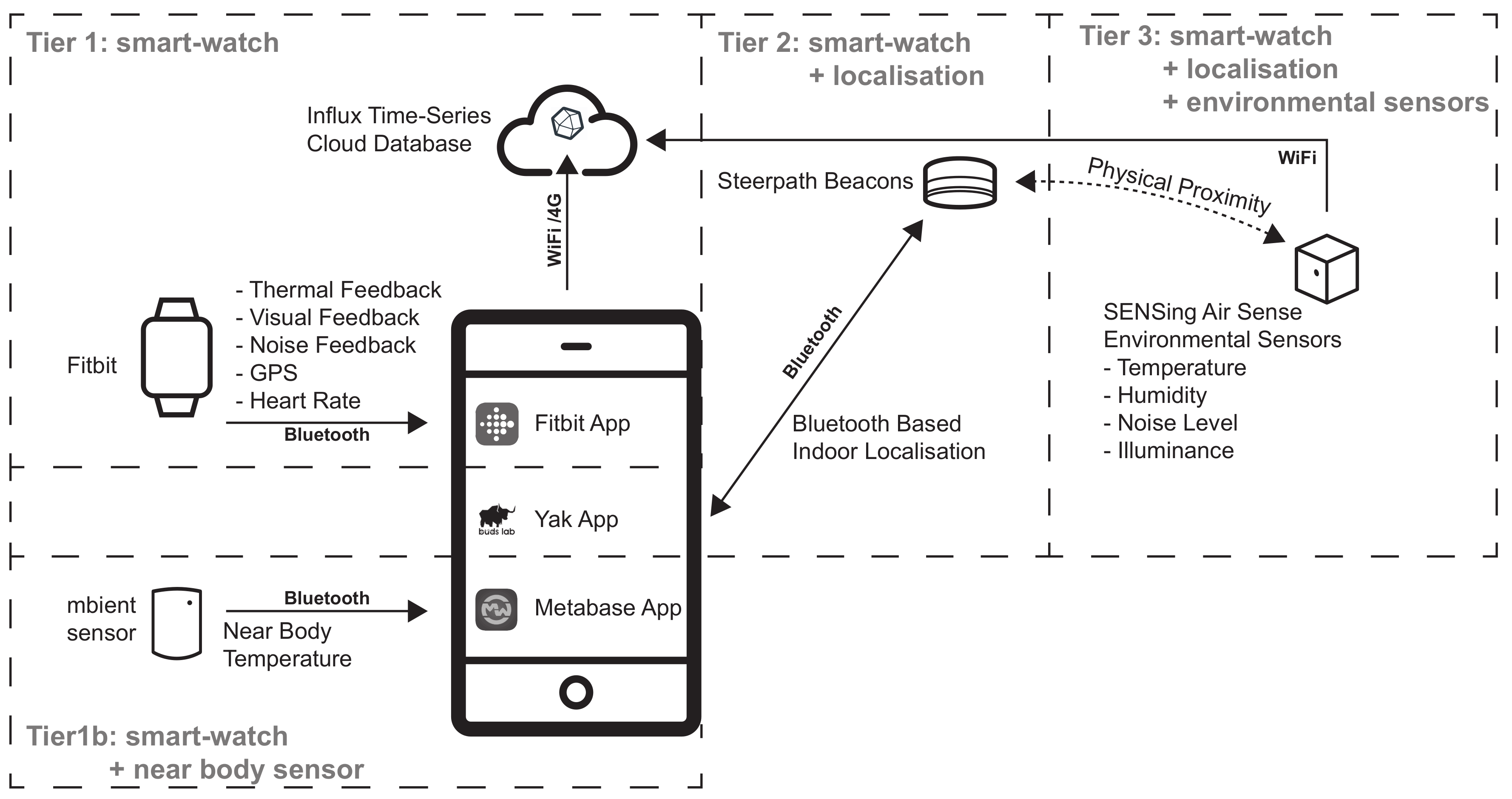
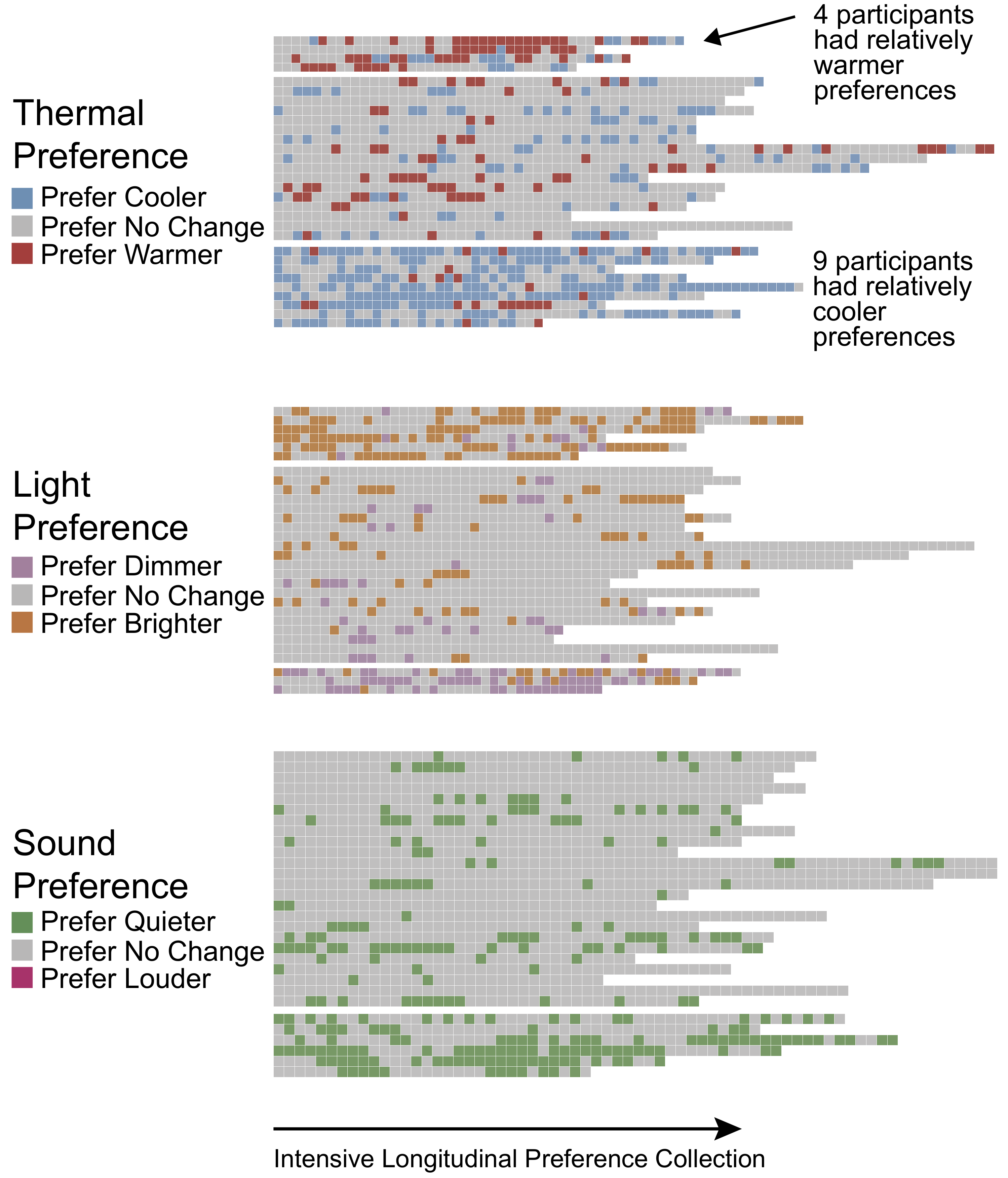
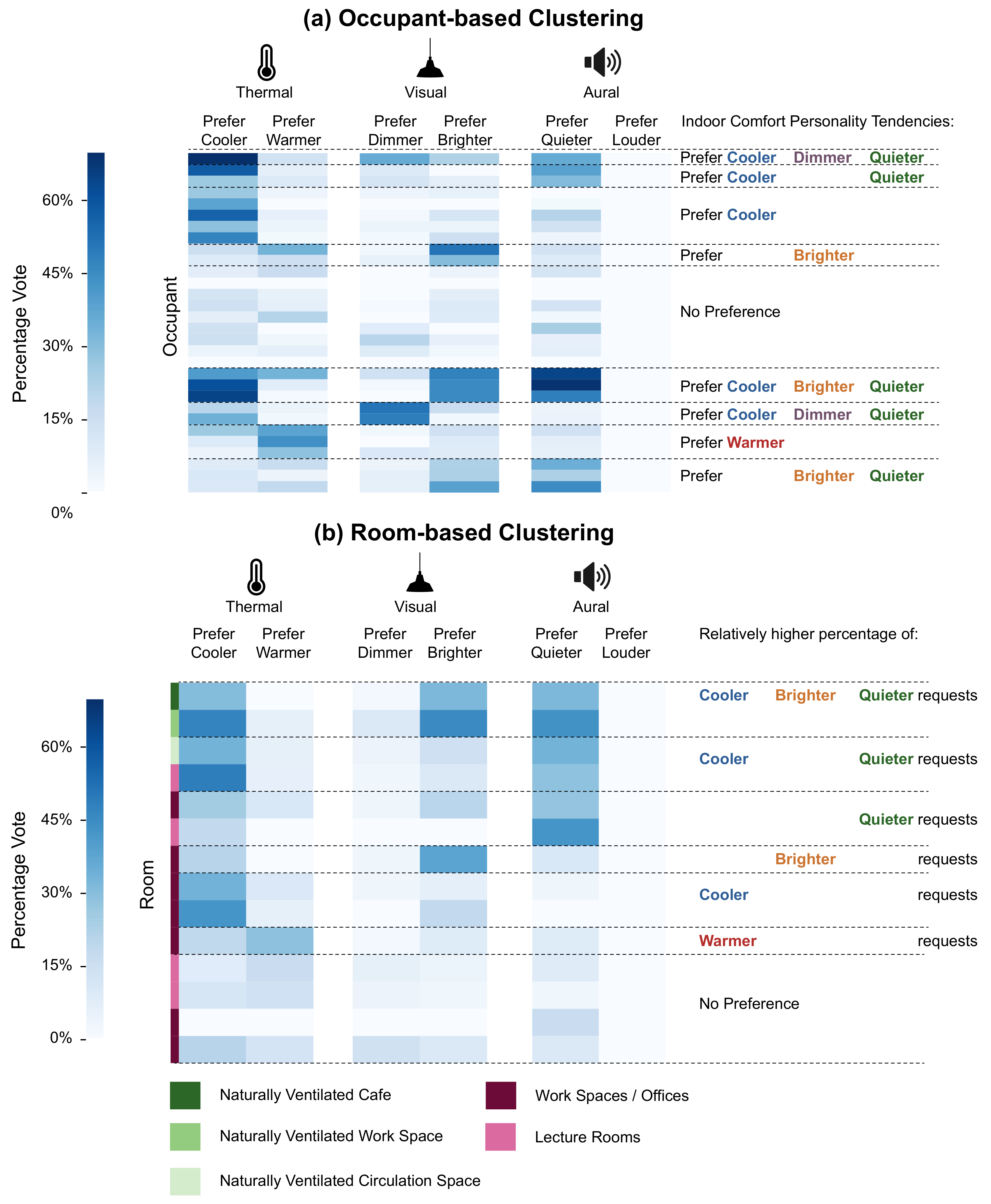

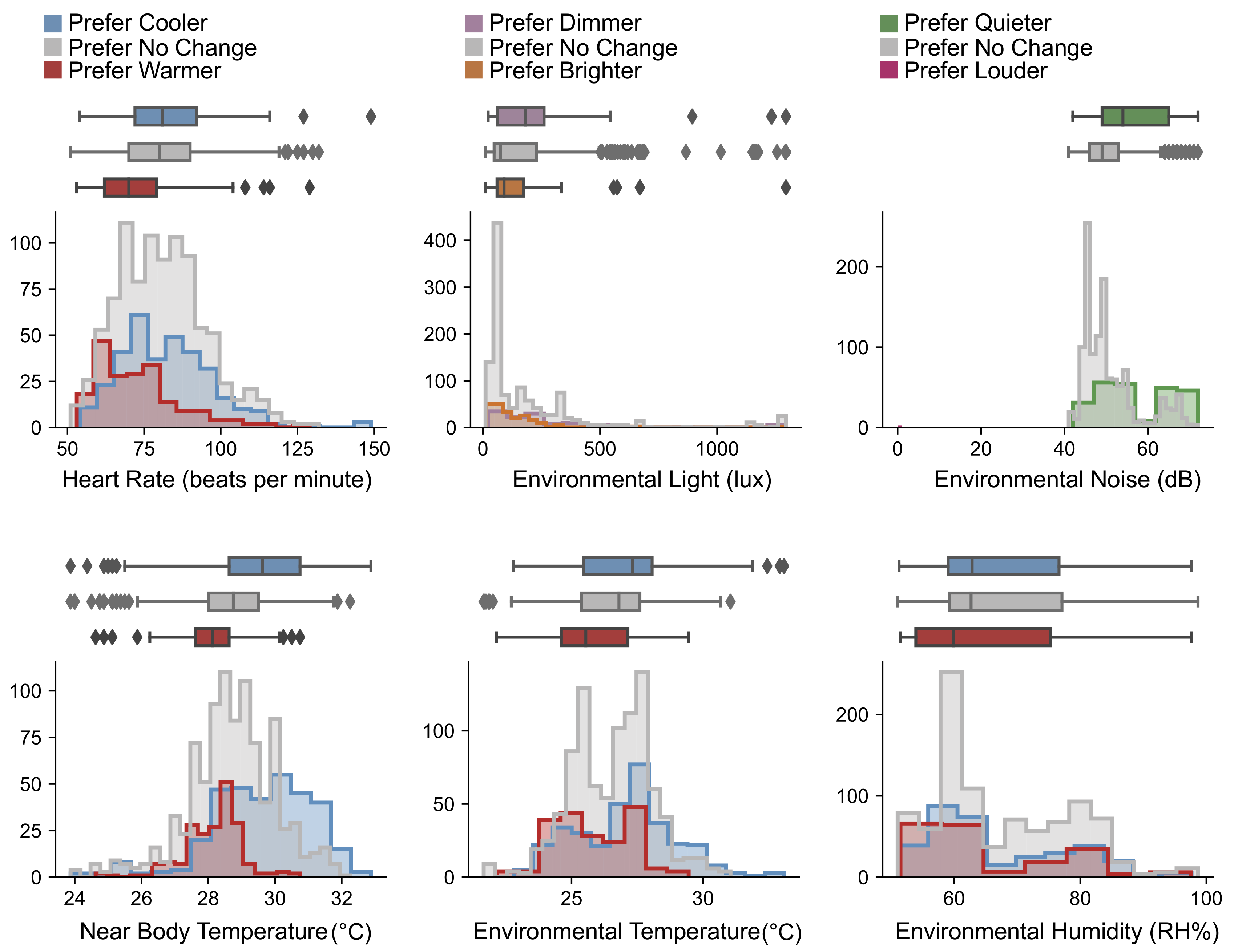
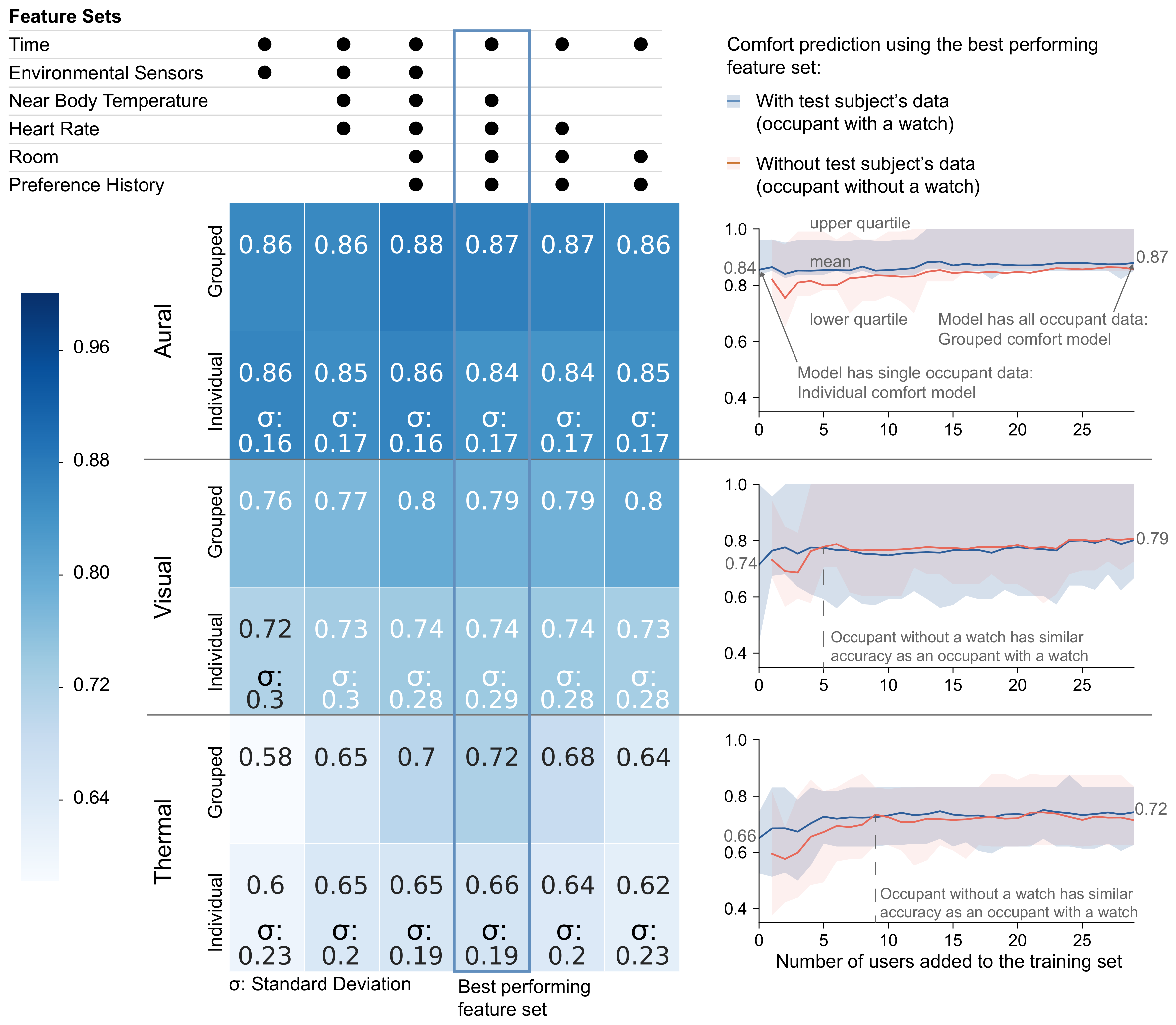
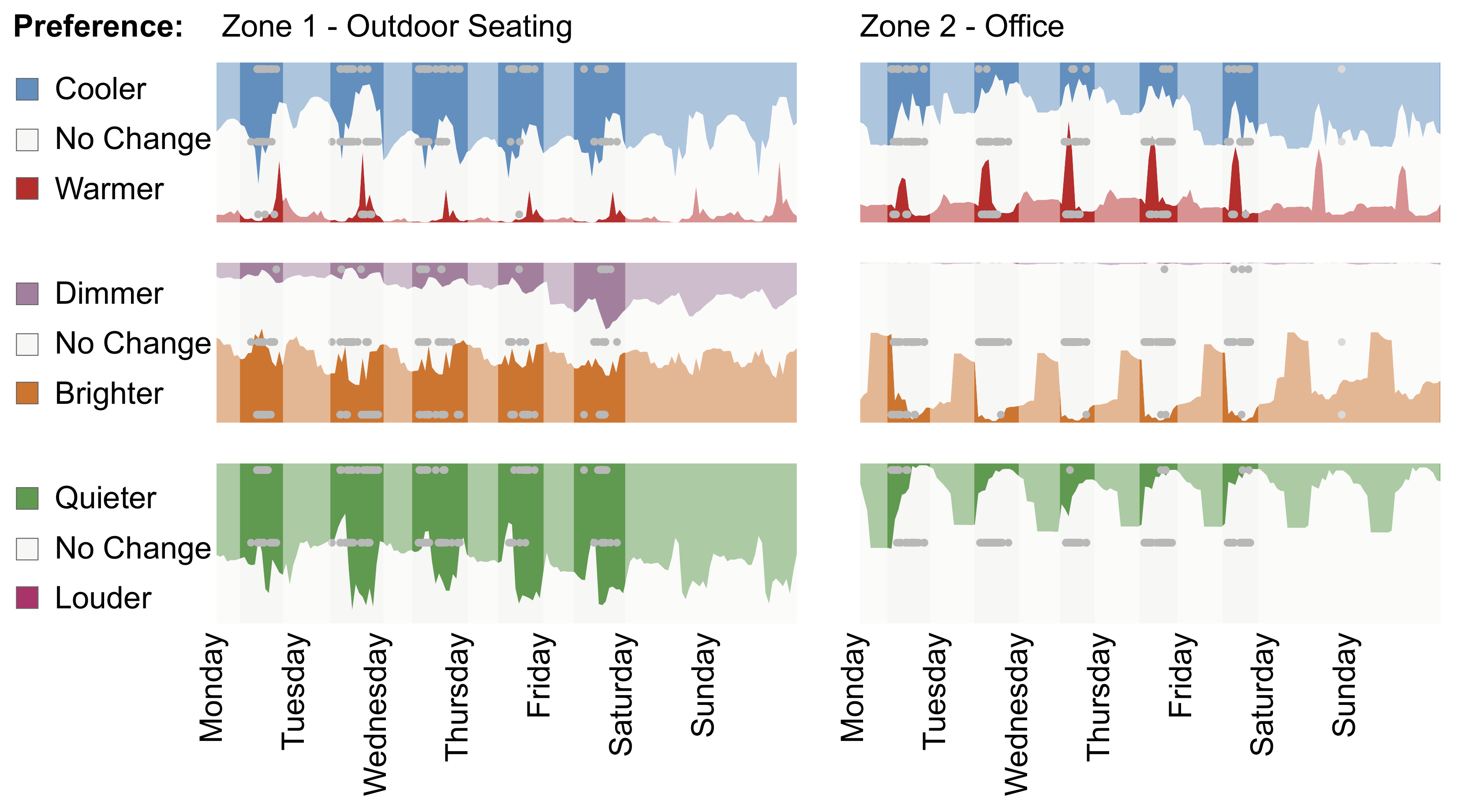
© 2020 by the authors. Licensee MDPI, Basel, Switzerland. This article is an open access article distributed under the terms and conditions of the Creative Commons Attribution (CC BY) license (http://creativecommons.org/licenses/by/4.0/).
Share and Cite
Jayathissa, P.; Quintana, M.; Abdelrahman, M.; Miller, C. Humans-as-a-Sensor for Buildings—Intensive Longitudinal Indoor Comfort Models. Buildings 2020, 10, 174. https://doi.org/10.3390/buildings10100174
Jayathissa P, Quintana M, Abdelrahman M, Miller C. Humans-as-a-Sensor for Buildings—Intensive Longitudinal Indoor Comfort Models. Buildings. 2020; 10(10):174. https://doi.org/10.3390/buildings10100174
Chicago/Turabian StyleJayathissa, Prageeth, Matias Quintana, Mahmoud Abdelrahman, and Clayton Miller. 2020. "Humans-as-a-Sensor for Buildings—Intensive Longitudinal Indoor Comfort Models" Buildings 10, no. 10: 174. https://doi.org/10.3390/buildings10100174
APA StyleJayathissa, P., Quintana, M., Abdelrahman, M., & Miller, C. (2020). Humans-as-a-Sensor for Buildings—Intensive Longitudinal Indoor Comfort Models. Buildings, 10(10), 174. https://doi.org/10.3390/buildings10100174





